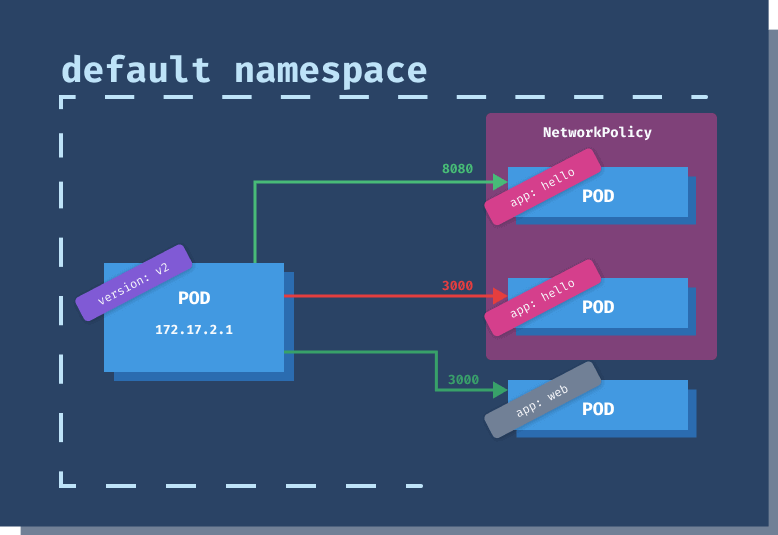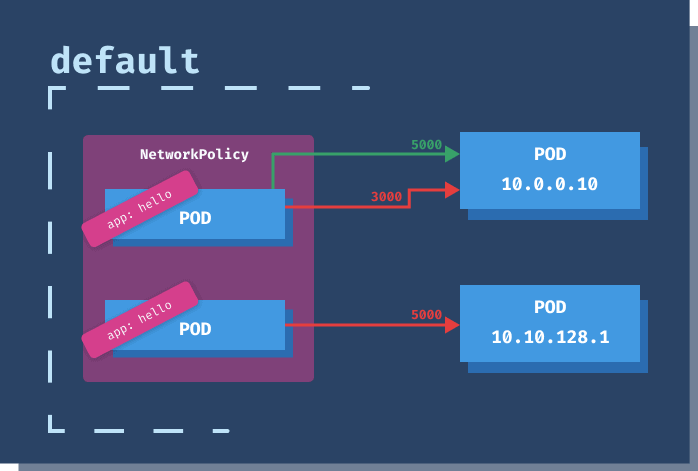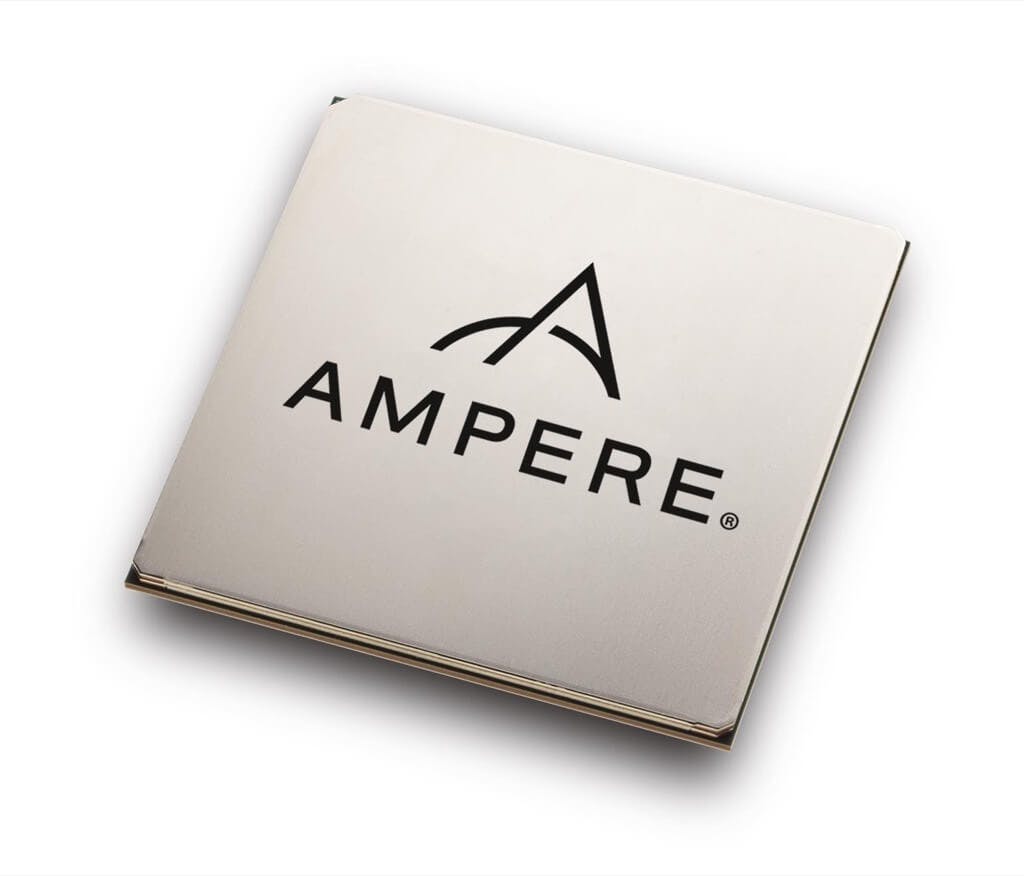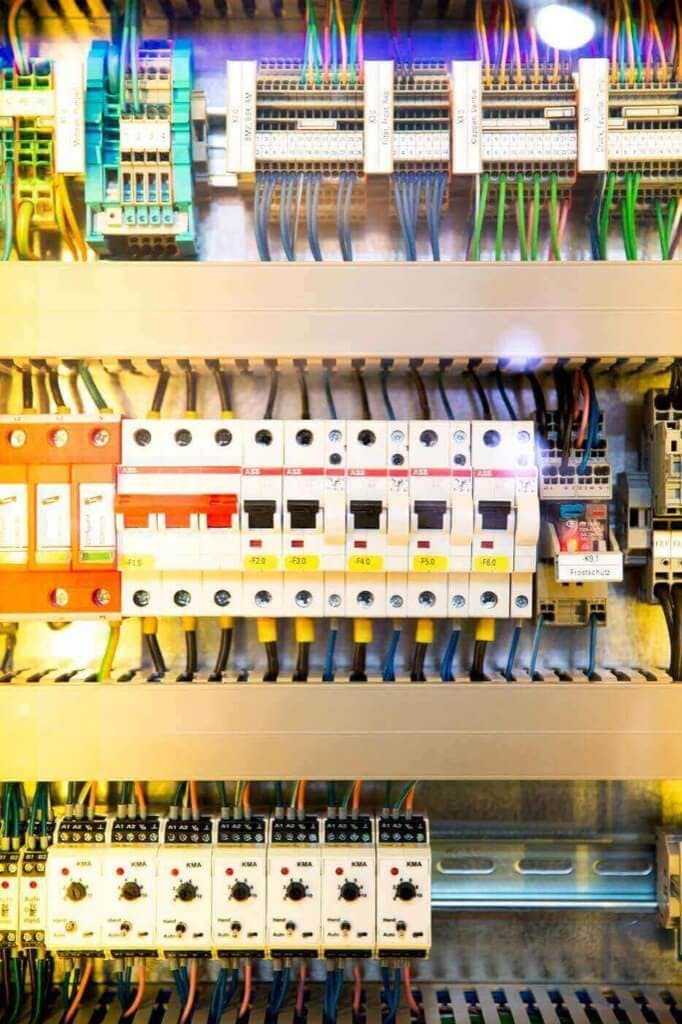
Kubernetes Network Policy
Using the NetworkPolicy resource, you can control the traffic flow for your applications in the cluster, at the IP address level or port level (OSI layer 3 or 4).
Network Policy
Note
Open Systems Interconnection model (OSI model) is a conceptual model that characterises and standardizes the communication functions, regardless of the underlying technology. For more information, see the OCI model.
- Select the Pods the policy applies to. You can do that using labels. For example, using
app=helloapplies the policy to all Pods with that label. - Decide if the policy applies for incoming (ingress) traffic, outgoing (egress) traffic, or both.
- Define the ingress or egress rules by specifying IP blocks, ports, Pod selectors, or namespace selectors.
apiVersion: networking.k8s.io/v1
kind: NetworkPolicy
metadata:
name: my-network-policy
namespace: default
spec:
podSelector:
matchLabels:
app: hello
policyTypes:
- Ingress
- Egress
ingress:
- from:
- ipBlock:
cidr: 172.17.0.0/16
except:
- 172.17.1.0/24
- namespaceSelector:
matchLabels:
owner: ricky
- podSelector:
matchLabels:
version: v2
ports:
- protocol: TCP
port: 8080
egress:
- to:
- ipBlock:
cidr: 10.0.0.0/24
ports:
- protocol: TCP
port: 500
podSelector tells us that the policy applies to all Pods in the default namespace that have the app: hello label set. We are defining policy for both ingress and egress traffic.172.17.0.0/16 (that's 65536 IP addresses, from 172.17.0.0 to 172.17.255.255), except for Pods whose IP falls within the CIDR block 172.17.1.0/24 (256 IP addresses, from 172.17.1.0 to 172.17.1.255) to the port 8080. Additionally, the calls to the Pods policy applies to can be coming from any Pod in the namespace(s) with the label owner: ricky and any Pod from the default namespace, labeled version: v2.
app: hello in the default namespace can make calls to any IP within 10.0.0.0/24 (256 IP addresses, from 10.0.0.0, 10.0.0.255), but only to the port 5000.
...
ingress:
- from:
- namespaceSelector:
matchLabels:
user: ricky
podSelector:
matchLabels:
app: website
...
from array, includes all Pods with labels app: website from the namespace labeled user: ricky. This is the equivalent of and operator.podSelector to be a separate element in the from array by adding -, you are using the or operator. ...
ingress:
- from:
- namespaceSelector:
matchLabels:
user: ricky
- podSelector:
matchLabels:
app: website
...
app: website or all Pods from the namespace with the label user: ricky.Install Cilium
cni flag for the Cilium to work correctly:$ minikube start --network-plugin=cni
$ kubectl create -f https://raw.githubusercontent.com/cilium/cilium/1.8.3/install/kubernetes/quick-install.yaml
all/kubernetes/quick-install.yaml
serviceaccount/cilium created
serviceaccount/cilium-operator created
configmap/cilium-config created
clusterrole.rbac.authorization.k8s.io/cilium created
clusterrole.rbac.authorization.k8s.io/cilium-operator created
clusterrolebinding.rbac.authorization.k8s.io/cilium created
clusterrolebinding.rbac.authorization.k8s.io/cilium-operator created
daemonset.apps/cilium created
deployment.apps/cilium-operator created
kube-system namespace, so you can run kubectl get po -n kube-system and wait until the Cilium Pods are up and running.Example
apiVersion: v1
kind: Pod
metadata:
name: no-egress-pod
labels:
app.kubernetes.io/name: hello
spec:
containers:
- name: container
image: radial/busyboxplus:curl
command: ['sh', '-c', 'sleep 3600']
no-egress-pod.yaml and create the Pod using kubectl apply -f no-egress-pod.yaml.google.com using curl:$ kubectl exec -it no-egress-pod -- curl -I -L google.com
HTTP/1.1 301 Moved Permanently
Location: http://www.google.com/
Content-Type: text/html; charset=UTF-8
Date: Thu, 24 Sep 2020 16:30:59 GMT
Expires: Sat, 24 Oct 2020 16:30:59 GMT
Cache-Control: public, max-age=2592000
Server: gws
Content-Length: 219
X-XSS-Protection: 0
X-Frame-Options: SAMEORIGIN
HTTP/1.1 200 OK
...
app.kubernetes.io/name: hello:apiVersion: networking.k8s.io/v1
kind: NetworkPolicy
metadata:
name: deny-egress
spec:
podSelector:
matchLabels:
app.kubernetes.io/name: hello
policyTypes:
- Egress
curl won't be able to resolve the host:$ kubectl exec -it no-egress-pod -- curl -I -L google.com
curl: (6) Couldn't resolve host 'google.com'
kubectl edit pod no-egress-pod and change the label value to hello123. Save the changes and then re-run the curl command. This time, the command works fine because we changed the Pod label, and the network policy does not apply to it anymore.Common Network Policies
Deny all egress traffic
apiVersion: networking.k8s.io/v1
kind: NetworkPolicy
metadata:
name: deny-all-egress
spec:
podSelector: {}
policyTypes:
- Egress
Deny all ingress traffic
apiVersion: networking.k8s.io/v1
kind: NetworkPolicy
metadata:
name: deny-all-ingress
spec:
podSelector: {}
policyTypes:
- Ingress
Allow ingress traffic to specific Pods
app: my-app.kind: NetworkPolicy
apiVersion: networking.k8s.io/v1
metadata:
name: pods-allow-all
spec:
podSelector:
matchLabels:
app: my-app
ingress:
- {}
Deny ingress to specific Pods
app: my-app.kind: NetworkPolicy
apiVersion: networking.k8s.io/v1
metadata:
name: pods-deny-all
spec:
podSelector:
matchLabels:
app: my-app
ingress: []
Restrict traffic to specific Pods
app: customers to any frontend Pods (role: frontend) that are part of the same app (app: customers).kind: NetworkPolicy
apiVersion: networking.k8s.io/v1
metadata:
name: frontend-allow
spec:
podSelector:
matchLabels:
app: customers
role: frontend
ingress:
- from:
- podSelector:
matchLabels:
app: customers
Deny all traffic to and within a namespace
podSelector) in the prod namespace. Any calls from outside of the default namespace will be blocked and any calls between Pods in the same namespace.kind: NetworkPolicy
apiVersion: networking.k8s.io/v1
metadata:
name: prod-deny-all
namespace: prod
spec:
podSelector: {}
ingress: []
Deny all traffic from other namespaces
prod namespace. It matches all pods (empty podSelector) in the prod namespace and allows ingress from all Pods in the prod namespace, as the ingress podSelector is empty as well.kind: NetworkPolicy
apiVersion: networking.k8s.io/v1
metadata:
name: deny-other-namespaces
namespace: prod
spec:
podSelector: {}
ingress:
- from:
- podSelector: {}
Deny all egress traffic for specific Pods
app: api from making any external calls.apiVersion: networking.k8s.io/v1
kind: NetworkPolicy
metadata:
name: api-deny-egress
spec:
podSelector:
matchLabels:
app: api
policyTypes:
- Egress
egress: []





